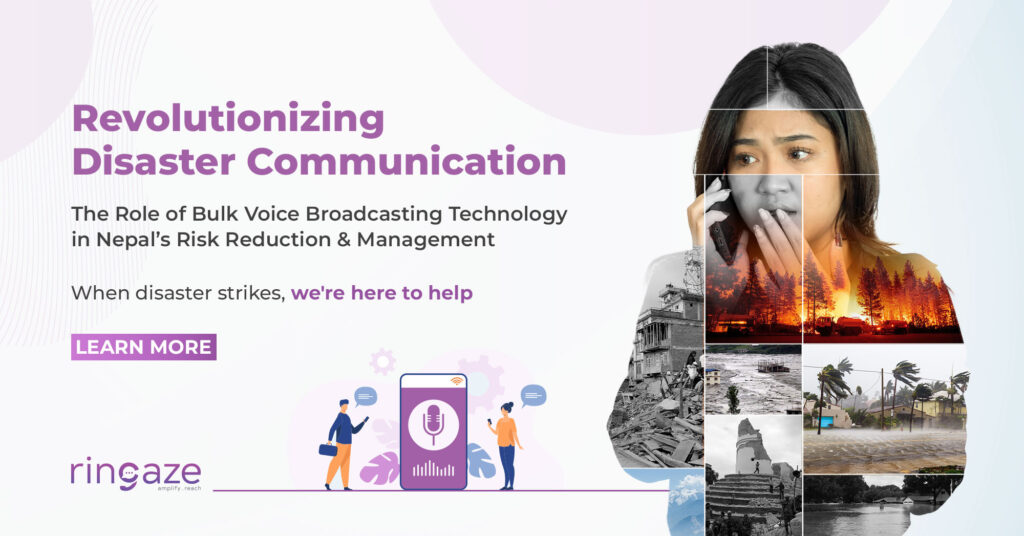Revolutionizing Disaster Communication: The Role of Bulk Voice Broadcasting Technology in Nepal’s Risk Reduction & Management
19 March 2023

In recent years, disaster risk reduction and management have become a pressing concern for governments and organizations worldwide. With the rise in natural disasters such as floods and earthquakes, there is a need for effective communication strategies to reach out to affected populations and provide them with timely and accurate information. This is where bulk voice broadcasting technology comes in, as it has proven to be an effective tool for disaster risk reduction and management communication in situations like river floods and earthquakes in Nepal and other parts of the world.
Bulk voice broadcasting technology is a communication tool that enables the delivery of pre-recorded voice messages to a large number of people simultaneously. This technology has been widely used in the past few years for various purposes, such as marketing and political campaigns. However, it has now found a new application in disaster risk reduction and management communication.
River floods are a common natural disaster that affects many countries, including Nepal. The country has a history of devastating floods that have caused significant loss of life and property damage. In such situations, communication is critical to ensuring the safety and well-being of the affected population. Bulk voice broadcasting technology enables the delivery of timely and accurate information to the affected communities, informing them about the flood situation and providing them with instructions on how to stay safe.
Similarly, earthquakes are another natural disaster that requires effective communication strategies. In the event of an earthquake, people need to be informed about the severity of the quake and whether there is a risk of aftershocks. They also need to be provided with instructions on how to respond, such as seeking shelter in a safe location. Bulk voice broadcasting technology can deliver these messages to a large number of people simultaneously, making it an effective tool for earthquake risk reduction and management communication.
In Nepal, bulk voice broadcasting technology has been used in recent years to communicate with communities affected by natural disasters. For example, during the 2015 earthquake, the Nepali government used bulk voice broadcasting technology to deliver messages to the affected population, informing them about the situation and providing instructions on staying safe. The technology has also been used to communicate with communities affected by river floods, enabling timely evacuation and reducing the risk of loss of life.
The use of bulk voice broadcasting technology for disaster risk reduction and management communication is not limited to Nepal. The technology has been used in other parts of the world as well. For example, in the United States, the Federal Emergency Management Agency (FEMA) has used technology to communicate with communities affected by natural disasters such as hurricanes and wildfires.
In conclusion, bulk voice broadcasting technology is a powerful tool for disaster risk reduction and management communication in river floods and earthquakes. It enables the delivery of timely and accurate information to a large number of people simultaneously, ensuring that the affected population is informed and prepared. With its proven effectiveness, governments and organizations around the world should consider incorporating this technology into their disaster risk reduction and management strategies.

Voice Broadcasting is a mastered path to reach to Rural areas whose most accessible medium of communication is Phone or mobile network. Reach out to your beneficiaries or audience with Voice Broadcasting.
Continue Reading
Introduction Disasters can cause significant loss of life and property, and effective early warning systems are crucial in mitigating risks. In Nepal, various organizations and government bodies have been working on developing community-based early warning systems to alert communities to potential disasters. Interactive Voice Response (IVR) is one such technology that can be useful in […]
Continue Reading
World Tuberculosis Day is observed annually on March 24 to raise public awareness about the devastating health, social, and economic consequences of TB, and to step up efforts to end the global TB epidemic. This day is a reminder of the urgent need to intensify actions to end TB, a preventable and curable disease that […]
Continue Reading